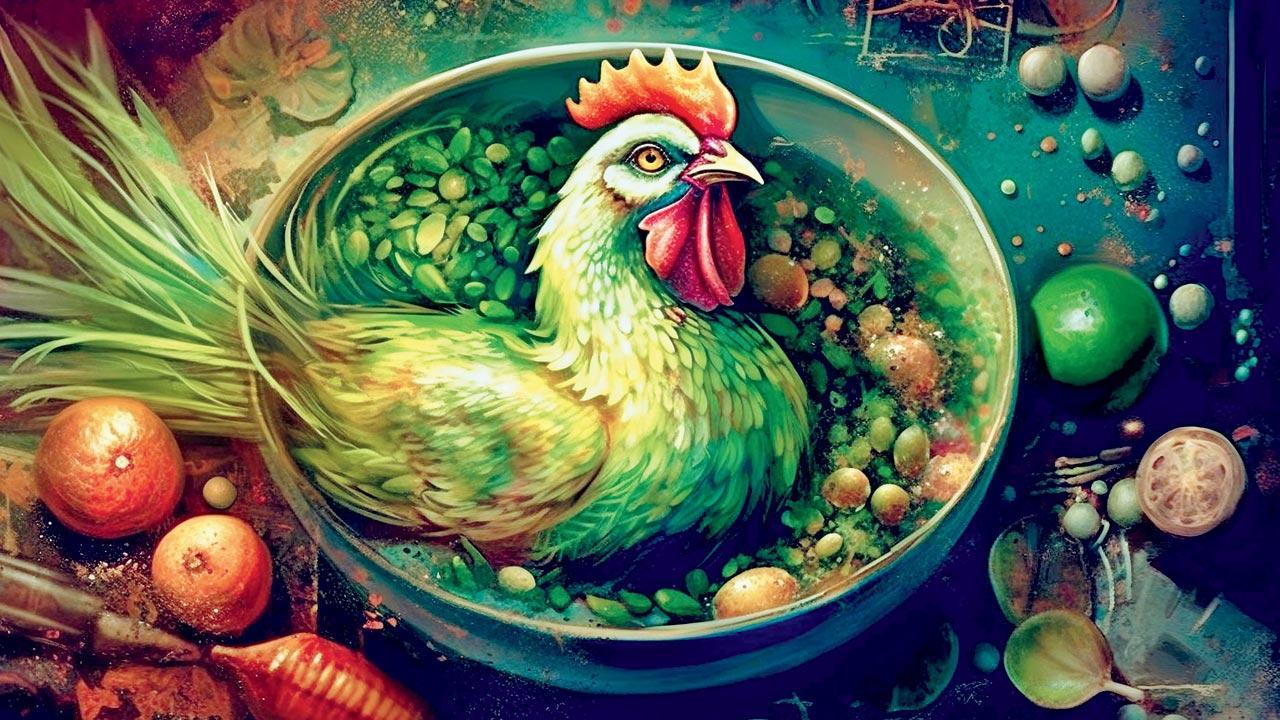If you want to know why the Thais are a nation of such happy people, it’s their roots. The galangal root, to be precise. Which you can’t get here in India

Galangal and lemongrass are the two irreplaceable additives that make the difference between a quickly-forgotten green curry and an authentic, unputdownable Thai green curry. Illustration by C Y Gopinath using Midjourney
 There’s a gal on both sides and an an in the middle. What could it be?
There’s a gal on both sides and an an in the middle. What could it be?
ADVERTISEMENT
It could be a crossword puzzle clue. It could be two kinky lasses from Transylvania. It could be a bad palindrome. Or it could be a spelling mistake.
None of the above. Galangal is nothing more than an occasion to fight about, especially for tuppenny gourmets who pretend Thai is a great way to fly. For example, I had a fight with myself about whether it was actually galangal or galingal. It got so intense that I nearly gave myself a black eye.
“You Dravidian twerp,” I screamed at myself. “It’s galangal, close to galagal, the Bengali word for strong abuse.”
“Shut up,” I roared back at myself. “See any packet of readymade Thai green curry past, and you will see it spelt as galingal, with an i.”
“I always knew you were the type to buy readymade curry pastes,” I sniggered, having spotted a chink in my armour. “For your information, Thais don’t call it either galangal or galingal. They call it—something else!”
“Ha!” I retorted.
“And it doesn’t grow in India,”
I added.
I was silent.
It’s a good time to talk about galangal because Indians now officially top the list of tourists visiting Thailand by numbers, just scraping past the Chinese. They’re everywhere, sniggering at the locals, looking for home-made food, checking out massage parlours and—looking for Thai food. Mostly Green Curry Chicken, if I’m honest.
While the male is out scoping the disreputable narrow streets, his wife is trying to master Thai cuisine to impress the girls in the knitting club back in Mumbai. Here she will encounter galangal.
She will be told it is an essential and key ingredient of Thai cooking. Galangal and lemongrass are the two irreplaceable additives that make the difference between a quickly-forgotten green curry and an authentic, unputdownable Thai green curry.
Here’s what my exotic book says about galangal. Verbatim: “The flavour is allied to ginger, but there is a predominantly pine and citrus scent to it.” If you’ve smelt neither pine nor citrus, let me paraphrase it for you: galangal smells sexy. It tantalises, seduces, and teases, cloaking the entire curry with magic.
There was a senior chef once at Hotel President who tried to grow galangal in a special plot behind his 5-star hotel, making several trips to Bangkok for research. He learnt on the very first trip that he had to ask for kha, using the downward tone. Nothing if not authentic, the chef brought back a few tons of soil from Thailand, and in it he planted lots of kha.
“Soil makes a big difference,” he told me, a man of detail to the bitter end. “Also, temperature, pressure, water quality and son. We have tried to duplicate Thai conditions in our greenhouses.”
Needless to say, his experiment was an epic fail. You cannot do in India what the Thais do in Thailand.
Back to the desperate housewife. Frantic to procure some real galangal, she will go from market to market asking for it and get blank looks. No one in Thailand, apparently, uses galangal. She doesn’t know about the kha with the downward tone.
My complex relationship with galangal started in my kitchen at home in Mumbai when a friend gifted me a plastic jar of readymade Thai Green Curry paste. The instructions were so simple, a defective schoolboy could have put the dish together. Measure 50 gms of curry paste for every 200 gms of meat or vegetables (any vegetables!). Add a couple of glasses of lovely, thick, fresh, creamy coconut milk. Let it simmer till the meat is done. Done.
That evening, everyone praised my proven culinary skills and I modestly dissented. “It is nothing,” I murmured. “Anyone can do it, even you. You just have to make the green curry paste—”
The second time I threw a green curry party, I didn’t have the packaged curry paste. I would have to make my own, I realised with a sinking feeling. I knew I could get lemongrass at Nature’s Basket—but you can’t get a good kha in India.
What you can’t get, you should replace. I had no alternative but to cheat and make the green curry paste without galangal. While at it, I threw out the lemongrass as well; in for a penny, in for a pound. Who would know the difference? Who’d even care? This is India, mother of democracy. We’re the jugad people.
The best Indian substitute for kha, in my opinion, is aamadrak (the ginger-like root born of a marriage between raw mango and ginger). You will get a green curry paste the right shade of emerald green, its texture coarse—and probably a taste no Thai restaurant would touch.
But it will be such a treat anyway that you might not give a hoot. Just follow the recipe for Indianised Jugad Green Curry Paste below.
____
Not seeing a recipe? That’s because you haven’t written me an email asking for it. Don’t forget to say please.
You can reach C Y Gopinath at cygopi@gmail.com
Send your feedback to mailbag@mid-day.com
The views expressed in this column are the individual’s and don’t represent those of the paper
 Subscribe today by clicking the link and stay updated with the latest news!" Click here!
Subscribe today by clicking the link and stay updated with the latest news!" Click here!







